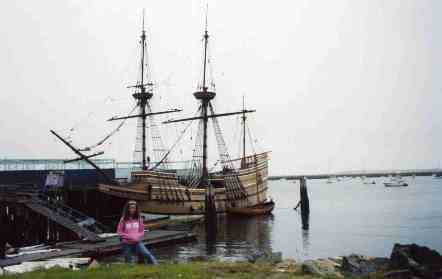
Mayflower
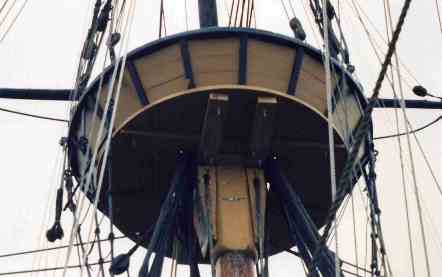
| Canoeing | Skiing | Bicycling | Forum |
Clothing |
Equipment |
Vehicles |
Readings |
 |
Mayflower |
 |
| Even though you may only spend an hour or so at the actual ship, the Mayflower will probably be the most vivid memory of your visit to Plymouth. For one thing, if you stay anywhere on Water Street, every time you look out your window her masts will dominate the scene. Every where you go downtown, the ship is in the background. It tends to show up in photos even though you're two blocks away and concentrating on something else. This one ship is such an icon of American myth, legend folklore and history that actually seeing it in real life is intensely dramatic. |  |
We recommend starting your first day in Plymouth with the Mayflower. Be among the first arrivals. This will avoid the lines that build later in the day. Plymouth Plantation, the Museum and other attractions are big enough to absorb and disperse crowds, but the Mayflower was not big enough for the 100 passengers who came over on it, and certainly is not big enough for the hordes of people who show up on chartered buses to love it to death. Heat is also a factor. Not even the Pilgrims could stay down in the hold during the afternoon heat. |
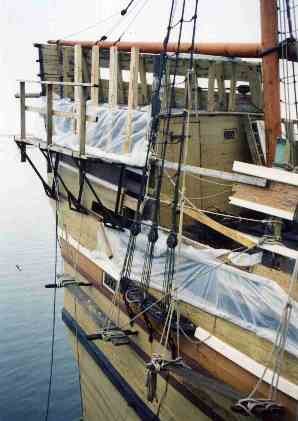 |
Despite the fact that this little ship crossed the ocean and survived 100 foot waves and severe storms, has endured hurricanes and Northeasters while anchored, and absorbs the footsteps of hundreds of thousands of visitors, when visiting you realize how fragile it really is. This is, after all, a very old wooden boat exposed to salt water, weather and sun. Continual maintenance is critical. It is on display only between Memorial and Labor Day each year. The other nine months are used for painstaking care: replacement of boards, beams and masts, polishing of brass fittings, sanding and painting, rerigging, sewing of new sails, and continuing treatment for barnacles and other wood borers. These photos were taken during a recent off season when the port side of the rear castle deck was rebuilt. Such work is done at the Mystic shipyard, where Naval architecture and history are studied and all work follows rigid historical standards. Incredibly, the original plans, even the paint scheme, were handed down through the Jones family until they donated them to British historians. So this appearance is exactly how the ship looked in 1620. But it's interesting to realize that after every board, hinge and beam have been replaced multiple times, there's absolutely nothing original about the Mayflower we visit today. Thus the "II" asterisk. | 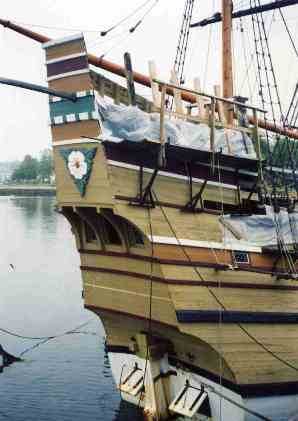 |
| But the Mayflower did have a phenomenal history. The Puritans were hunted criminals back in England and were forbidden from leasing any passenger ship, so they signed up Captain Christopher Jones and this small freight ship which usually transported wine, cheese and textiles between England and Europe. Even so, they had to smuggle their leader, William Brewster, aboard in a shipping trunk and then conceal him under the floorboards of the hold, so the constantly searching police could not find and arrest him. | 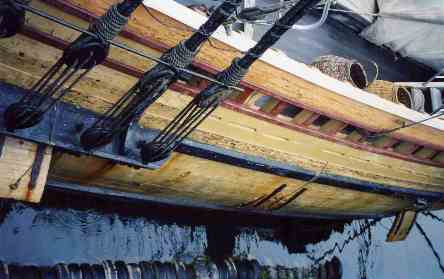 |
Once it slipped out of the harbor before dawn, the Mayflower faced more problems. It was built to navigate the English channel, tight French, Dutch and British harbors and rivers, and make small cruises out to the Canaries, Madeira and other islands close to the continent, where it could flee bad weather by retreating to the nearest harbor. It was not built for ocean crossings or severe weather. The six week Atlantic crossing beat it to death, climaxed by the hurricane which blew it off course. |
| Since schools have pretty well abandoned the teaching of early American history, people don't know as much about the Mayflower's voyage as they used to. Everyone no longer realizes the Pilgrims actually had a charter for land at the mouth of the Hudson. They were blown far North of their course by the hurricane, which also snapped the masts, shredded the sails, shattered the rudder and caved in the heavy beam running from end to end below the main deck. Only by using their giant jack screw which they had brought to build houses were the Pilgrims able to brace the beam and keep the ship afloat, but with neither sails nor rudder they were adrift, at the mercy of the sea. With the wind and currents pushing them steadily north, and food running out, they were very close to perishing in the vast stretches of the North Atlantic. Miraculously, they washed up on the shallows of Cape Cod. They found enough timber out there to repair the ship while a group of five took the small boat and explored the coast looking for a better location. They chose Plymouth due to Town Brook's fresh water. | 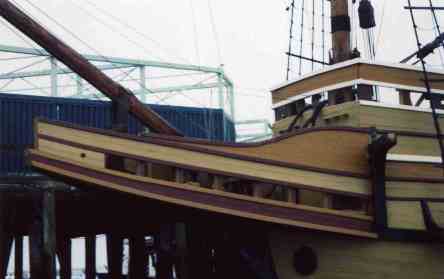 |
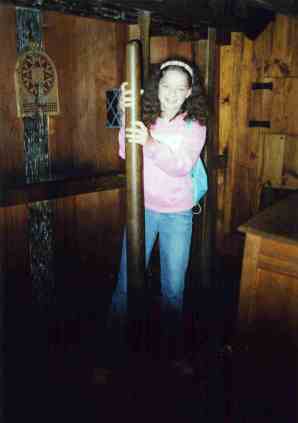 |
People also tend to forget that in 1620 ships were not crisscrossing the oceans. They hugged the coastlines. Ships did not have the "modern" technology we take for granted. There were no compasses, the steering wheel had not yet evolved, and hulls had to be continually recalked with tar to keep them from leaking. The photo at left shows the steering bar of the Mayflower. Turning it turns the shaft, shown at lower right,which pulls ropes attached to the rudder That rudder was attached to a vertical shaft which pivoted back and forth as the ropes pulled from left or right. It was not until much later that the idea of gears evolved. Clearly, these primitive ships were not equipped to handle high winds, strong currents, or heavy weather, and required continuing maintenance. Yet Columbus, Sir Francis Drake, Sir Walter Raleigh, Henry Cabot, Christopher Jones and others did sail their ships across the Atlantic, some of them numerous times. They did so by plotting routes that went far out of their way to take advantage of any islands available. The Mayflower, for instance, went down the coast of France, then to Madeira and the Canaries, before heading northwest toward Virginia. And, even in 1620, 130 years after Columbus, |
longitude had still not been defined, so while a captain
could use a sextant or slider to determine latitude (North-South), he
had absolutely no way to determine how far West he was. Thus, while Christopher
Jones knew of Cape Cod, he was surprised to actually find it. 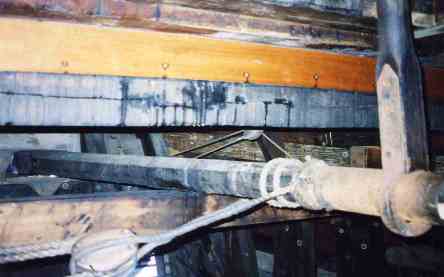 |
| We also tend to forget that the Pilgrims and even the crew of the Mayflower had to prepare all their meals on board ship for the two months they were at sea. There is actually a brick oven built into the ship within the bow, one deck down. This oven was built for a crew of about a dozen, so was much too small for a passenger list of 100. But by taking turns they managed, some people eating early and others late. Certainly no one imagined they would be forced to rely on this same oven all Winter after reaching land. | 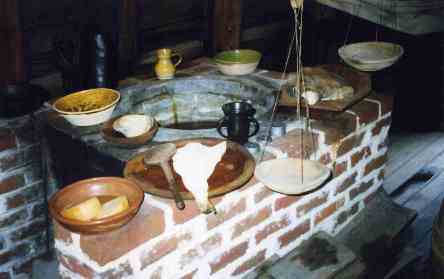 |
We urge you to read up on the Mayflower and her voyage before your visit. To appreciate what you're seeing, you need time to absorb a lot of details. You will then arrive with questions you can answer either by looking at those parts of the ship or by asking the interpreters. We had questions about the crows nest, the sail rigging, the paint design, and the rudder mechanics. The new book Mayflower by Nathaniel Philbrick goes a great job with the story of the Pilgrims themselves, but others are better with the actual ship. |
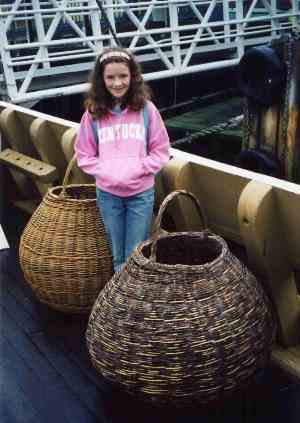 |
There are several interpretors on board the Mayflower. They will present information, then answer any questions. Dressed in correct 1620 garb, speaking in the Pilgrim accents, they do a great job. Most are either descendants of the Puritans, or students of American History at a Massachusetts university. However, they are too great a resource to waste. You might want to discuss with your students or your own kids what good questions might be, and head off foolishness. You don't want to waste valuable time that either you could use to learn more, or that others can use if you have no legitimate questions. You also want to think carefully about photographs. For most families or student groups, this is a once in a lifetime trip. They may not get back for a long time, if ever. A good collection of photographs can be used several years in the future for Powerpoint presentations, papers, or other school projects. So we suggest you discuss with your students or kids what makes a good photograph and what is a waste of time. If they want to take a silly picture with their cell phone, that's their privilege. But they should return home with a roll of film or a digital card containing 24 or 36 valuable photographs. |
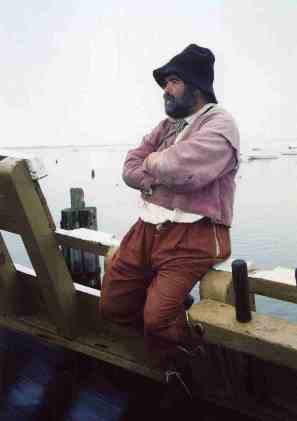 |
| You might want to contact Plimouth Plantation ahead of time and inquire about special programs involving the Mayflower. You might be able to schedule your trip to take advantage of those. Being able to go out on a sail, for a few hours, a day, or overnight (to Provincetown and back) would be an incredible opportunity. As you can imagine, these trips fill up well in advance. There are also training programs in sailing or other tasks that kids would remember forever, and adults would enjoy, too. A rowing trip in the shallop is also a possibility. | 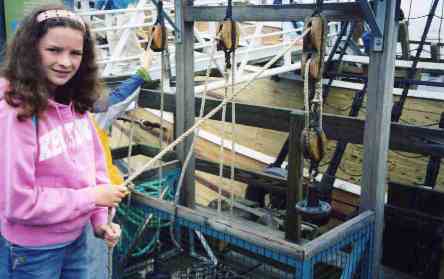 |
The apparatus at left is a good example. This helps teach kids about the rigging of sails, and the use of pulleys to raise and lower cargo for loading. Simple block and tackle arrangements were once taken for granted everywhere, but most kids have never been exposed to them. Be sure to allow enough time for your visit to the Mayflower that you and your kids or students can take advantage of these displays, these teachings, these learning opportunities. Too many visitors rush through each stop in an hour. |
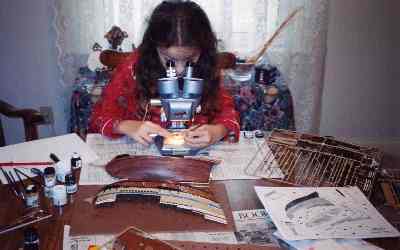 |
There's too much for kids to absorb in a Mayflower visit . Advance knowledge helps. We recommend building a model Mayflower back home during the Winter preceding your trip. Students can obtain class credit for doing so. There are several kits available. We like the Heller kit. We use dental floss for the rigging, soften it with a hairdryer, tighten it, and when it cools it shrinks, snugging up the rigging nicely. We use a stereoscope from Biology lab to paint tiny details like window panes and door hinges. This model took a sixth grader a month to complete. | 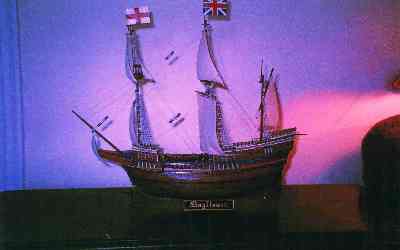 |
|
|||
|